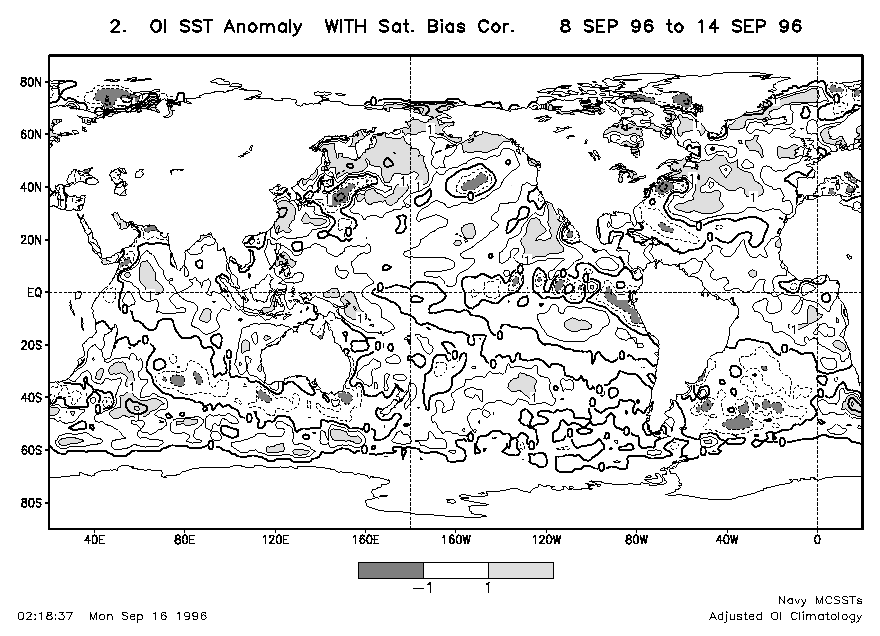
Because the CCA (Barnston 1994) and OCN (Huang et al. 1995) methods are now being used for the official operational long-lead seasonal forecasts issued by the Climate Prediction Center of NCEP, they will no longer be presented in detail in this Experimental Forecast Bulletin. However, a brief summary of these forecasts, as well as that of the NCEP coupled model (Ji et al. 1994a,b), for Oct-Nov-Dec 1996 and Jan-Feb-Mar 1997 is provided. For further information about the official NCEP forecasts, the following U.S. Regional Climate Center (RCC) Offices may be contacted:
Northeastern RCC 607-255-5950 Southeastern RCC 803-737-0800 Southern RCC 504-388-5021 Midwest RCC 217-244-8226 High Plains RCC 402-472-8294 Western RCC 702-677-3106
The forecasts themselves are contained in the Climate Outlook,
available on Internet with address: http://nic.fb4.noaa.gov. That same
address can also be used to access the web site for this Bulletin, as follows:
http://nic.fb4.noaa.gov/products/predictions; then click on "product
A-Z list".
U.S. Surface Climate Forecasts for Oct-Nov-Dec '96
Temperature: OCN forecasts anomalous cold in the midsection of the
country, warm in south Florida. CCA predicts cold in western Alaska, warm
in Hawaii. The coupled model dynamical forecast does not call for any coherent
large scale anomaly patterns in the U.S.
Precipitation: CCA predicts dryness in western Alaska. OCN predicts wetness
in much of the country's midsection and parts of Midwest. The coupled model
dynamical forecast does not call for any large scale anomaly patterns in
the U.S.
U.S. Surface Climate Forecasts for Jan-Feb-Mar '97
Temperature: CCA predicts anomalous warmth in the eastern U.S.--especially
the Great Lakes/Midwest, cool in 2 northern Hawaiian islands. OCN forecasts
warmth along eastern seaboard (except Florida), Texas and the Southwest.
The NCEP coupled model calls for below normal in Florida, the Great Lakes
and Maine.
Precipitation: CCA predicts anomalous dryness around the Great Lakes. OCN
predicts above median rainfall in parts of the Southwest and in the Florida
panhandle. The NCEP coupled model predicts anomalous dryness in most of
Florida.
Note: The above forecast descriptions include only regions whose estimated
cross-validated correlation skill exceeds 0.3. Highest local skills are
usually in the neighborhood of 0.6, but this varies with season, lead time
and forecast tool.
ENSO-Related SST
CCA (Barnston and Ropelewski 1992, Smith et al. 1995) predicts slightly
below normal SST conditions in Nino 3.4 (120-170oW, 5 oN-5
oS) through early winter 1996-97, switching to a weak positive
anomaly by late winter and becoming a warm episode (with low forecast confidence)
during 1997. Specifically, the forecast calls for the following standardized
anomalies and cross-validated correlation skills:
|
forecast |
skill |
|
| Oct-Nov-Dec 1996 |
-0.39 |
0.89 |
|
Jan-Feb-Mar 1997 |
0.08 |
0.78 |
|
Apr-May-Jun 1997 |
0.96 |
0.44 |
|
Jul-Aug-Sep 1997 |
1.41 |
0.25 |
|
Oct-Nov-Dec 1997 |
1.50 |
0.26 |
The forecast for Oct-Nov-Dec 1996 is a skill-weighted average of
CCA and simple persistence of the anomaly observed in Jun-Jul-Aug, because
persistence and CCA skills are roughly equivalent for that forecast. Longer
lead forecasts reflect only CCA. The global field of SST anomaly for September
8-14, 1996 (Fig. 1) shows the currently still slightly below normal SST
in parts of the eastern equatorial Pacific.
References
Barnston, A.G., 1994: Linear statistical short-term climate predictive
skill in the Northern Hemisphere. J. Climate, 5, 1514-1564.
Barnston, A.G. and C.F. Ropelewski, 1992: Prediction of ENSO episodes using
canonical correlation analysis. J. Climate, 7, 1316-1345.
Huang, J., H.M. van den Dool and A.G. Barnston, 1996: Long-lead seasonal
temperature prediction using optimal climate normals. J. Climate, 9,
809-817.
Ji, M., A. Kumar and A. Leetmaa, 1994a: A multi-season climate forecast
system at the National Meteorological Center. Bull. Am. Meteor. Soc.,
75, 569-577.
Ji, M., A. Kumar and A. Leetmaa, 1994b: An experimental coupled forecast
system at the National Meteorological Center: Some early results. Tellus,
46A, 398-418.
Reynolds, R.W. and T.M. Smith, 1994: Improved global sea surface temperature
analysis using optimum interpolation. J. Climate, 7, 929-948.
Smith, T.M., A.G. Barnston, M. Ji and M. Chelliah, 1995: The impact of
Pacific Ocean subsurface data on operational prediction of tropical Pacific
SST at the NCEP. Wea. Forecasting, 10, 708-714.
Figures

Fig. 1. NCEP optimum interpolation (OI; Reynolds and Smith 1994)
global SST anomaly field for the week of September 8-14, 1996.